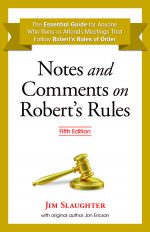The reviewing side of Publisher’s Weekly recently posted great reviews of my latest books, Robert’s Rules of Order Fast Track and Notes and Comments on Robert’s Rules, Fifth Edition. Each was also selected as an “Editor’s Pick,” which is described as “a book of outstanding quality.”
Because the reviews are on a scrolling site (with latest reviews on top), the reviews are reprinted below. Read these and other reviews at Latest Reviews.
Robert’s Rules of Order Fast Track: The Brief and Easy Guide to Parliamentary Procedure for the Modern Meeting


Crisp, clear, and always on-point, Slaughter’s “fast track” guide to parliamentary procedure exemplifies, in its inviting lucidity and respect for everyone’s time, just what productive meetings should be like. Slaughter (author of Notes and Comments on Robert’s Rules) boils Robert’s Rules of Order down to a set of essential procedures and concepts, adaptable to the needs of a diverse array of organizations, in the interest of getting meetings on track, establishing fair and orderly processes for arriving at group decisions, and instituting formal practices to protect organizations and their members. Writing with upbeat directness, Slaughter explicates how quorums, motions, the taking of minutes, and the ordering of business all work—and can work for your particular org.
He also demonstrates why they work, illuminating throughout the first-principles logic behind the rules of order, noting without condescension that the quorum, for example, “protects the organization by preventing a very small number of members from taking action on behalf of the entire organization.” In short, this compact guide offers order without fuss, always with an eye toward how meetings are run today, and what steps individual organizations can take to ensure productivity and fairness. (Rules that seem strict “are necessary to be fair,” Slaughter explains, because “you can’t easily have a conversation with a thousand people.”)
Especially helpful are up-to-date chapters covering meetings in the age of Zoom, including the challenges of voting “virtually,” why it’s best to set shorter speaking limits than at an in-person meeting, and this resounding truth: “one person having a Wi-Fi issue cannot be the basis for repeating everything.” Slaughter also sometimes addresses realities beyond the formal rules of order, like the fact that attendees at virtual (or hybrid) meetings are likely to be less engaged, possibly more churlish, and generally harder to rouse into a feeling of community. His tips for handling all this are clear-eyed, practical, and worth implementing, much like the Rules of Order themselves.
Takeaway: This admirably clear, concise guide to Robert’s Rules of Order will get meetings on track.
Production grades
Cover: A-
Design and typography: A
Illustrations: N/A
Editing: A
Marketing copy: A
Notes and Comments on Robert’s Rules, Fifth Edition


Jim Slaughter (Robert’s Rules of Order Fast Track), with original author Jon Ericson, delivers the fifth edition of an intermediate commentary covering the most asked questions of the parliamentary procedure manual, Robert’s Rules of Order. Employing a Q&A format, Slaughter lays the foundation of several fundamental principles, including the order of precedence, the different types of motions as well as their function, and the amending process, eventually moving on to more auxiliary issues such as quorum, voting, and how to handle electronic meetings. The information, though dense, is thoughtfully structured and clearly organized, with full references to further resources as needed, alongside an index to enhance accessibility.
Readers should come with a basic knowledge of Robert’s Rules already in place, as Slaughter recommends some introductory titles but clarifies that his work covers “the most-likely-to-be-experienced procedures” and the “why” behind parliamentary meeting methods. His history of parliamentary procedure, although brief, is helpful in setting the guide’s context, and he includes several charts for quick reference—as well as an exhaustive resource list that identifies organizations for further training and materials for more in-depth study. Slaughter’s clever use of humor enlivens the complex subject matter while still managing to deliver precise, straightforward explanations. Most importantly, he offers readers both sides of difficult scenarios, along with his wisdom and expertise, leaving them the necessary space to draw their own conclusions.
While intended as a commentary rather than a stand-alone volume, Notes and Comments will prove invaluable when combined with Robert’s Rules and other resources. Throughout, Slaughter recognizes the core goal of parliamentary procedure as balancing the rights of the individual in a meeting with the majority right for that meeting to be efficient and productive. Any readers already familiar with parliamentary procedure will find this a helpful guide to sharpen their skills.
Takeaway: An expert guide addressing the most commonly faced issues from Robert’s Rules of Order.
Production grades
Cover: A-
Design and typography: A
Illustrations: NA
Editing: A
Marketing copy: A
Jim Slaughter is an attorney, Certified Professional Parliamentarian, Professional Registered Parliamentarian, and past President of both CAI’s College of Community Association Lawyers (CCAL) and the American College of Parliamentary Lawyers (ACPL). He is author of four books on meeting procedure, including Robert’s Rules of Order Fast Track and Notes and Comments on Robert’s Rules, Fifth Edition. For more information, visit www.jimslaughter.com.

